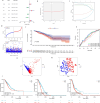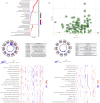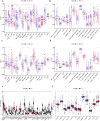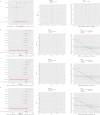Synergistic bioinformatics and sophisticated machine learning unveil ferroptosis-driven regulatory pathways and immunotherapy potential in breast carcinoma
- PMID: 40320501
- PMCID: PMC12050258
- DOI: 10.1007/s12672-025-02393-7
Synergistic bioinformatics and sophisticated machine learning unveil ferroptosis-driven regulatory pathways and immunotherapy potential in breast carcinoma
Abstract
Background: The intersection of aberrant iron metabolism and the rapidly advancing field of immunotherapy has emerged as a critical focus in breast cancer (BRCA) therapeutics. Ferroptosis, a distinct form of iron-dependent cell death driven by lipid peroxidation, has garnered increasing attention for its pivotal role in cancer progression.
Methods: Utilizing extensive datasets from TCGA and GEO, this research extracted a wealth of biological data, including mRNA splicing indices, genomic aberrations, copy number variations (CNV), tumor mutational burden (TMB), and diverse clinical information. Through precise Lasso regression analysis, this research constructed a prognostic model that elucidates the molecular interactions of FRGs in BRCA. Concurrent co-expression network analyses were performed to explore the dynamic interplay between gene expression patterns and FRGs, revealing potential regulatory mechanisms.
Results: This research analysis revealed significant overexpression of FRGs in high-risk BRCA samples, highlighting their prognostic relevance beyond traditional clinical parameters. GSVA identified immune response and cancer-related pathways as predominantly active in high-risk groups, suggesting ferroptosis as a central modulator within the tumor microenvironment. Notably, genes such as ACTL8, VGF, and CPLX2 emerged as markers of tumorigenesis, while IL33 and TP63 were identified as potential key regulators of cancer progression, each exhibiting distinct expression profiles across risk levels. Furthermore, this research incorporated gene correlations, CNV profiles, SNP arrays, and drug susceptibility analyses, contributing to the advancement of precision oncology.
Conclusions: The integration of bioinformatics and machine learning in this study underscores a strong correlation between FRG expression patterns and BRCA prognosis, affirming their potential as precise biomarkers for personalized immunotherapy.
Keywords: BRCA; CNV; Drug prediction; Drug prediction; Ferroptosis; Immune checkpoint; Immunity; m6a.
© 2025. The Author(s).
Conflict of interest statement
Declarations. Ethics approval and consent to participation: This manuscript is not a clinical trial, hence the ethics approval and consent to participation is not applicable. Consent for publication: Not applicable. Competing interests: The authors declare no competing interests.
Figures












Similar articles
-
Identification of clinical prognostic factors and analysis of ferroptosis-related gene signatures in the bladder cancer immune microenvironment.BMC Urol. 2024 Jan 3;24(1):6. doi: 10.1186/s12894-023-01354-y. BMC Urol. 2024. PMID: 38172792 Free PMC article.
-
Identification of a Novel Ferroptosis-Related Gene Prediction Model for Clinical Prognosis and Immunotherapy of Colorectal Cancer.Dis Markers. 2021 Nov 24;2021:4846683. doi: 10.1155/2021/4846683. eCollection 2021. Dis Markers. 2021. PMID: 34868393 Free PMC article.
-
Multi-omics analysis for ferroptosis-related genes as prognostic factors in cutaneous melanoma.Zhong Nan Da Xue Xue Bao Yi Xue Ban. 2024 Feb 28;49(2):159-174. doi: 10.11817/j.issn.1672-7347.2024.230401. Zhong Nan Da Xue Xue Bao Yi Xue Ban. 2024. PMID: 38755712 Free PMC article.
-
Identification of hepatocellular carcinoma-related subtypes and development of a prognostic model: a study based on ferritinophagy-related genes.Discov Oncol. 2023 Aug 9;14(1):147. doi: 10.1007/s12672-023-00756-6. Discov Oncol. 2023. PMID: 37555866 Free PMC article.
-
Novel Prognostic Signature for Acute Myeloid Leukemia: Bioinformatics Analysis of Combined CNV-Driven and Ferroptosis-Related Genes.Front Genet. 2022 Apr 26;13:849437. doi: 10.3389/fgene.2022.849437. eCollection 2022. Front Genet. 2022. PMID: 35559049 Free PMC article.
References
LinkOut - more resources
Full Text Sources
